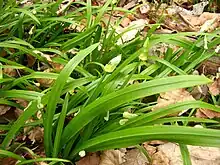Allium paradoxum
Allium paradoxum, the few-flowered garlic[2] or few-flowered leek, is an Asian species of wild onion in the Amaryllis family. It is native to mountainous regions of Iran, Caucasus, and Turkmenistan and invasive in Europe.
| Few-flowered garlic | |
|---|---|
 | |
| Allium paradoxum | |
| Scientific classification | |
| Kingdom: | Plantae |
| Clade: | Tracheophytes |
| Clade: | Angiosperms |
| Clade: | Monocots |
| Order: | Asparagales |
| Family: | Amaryllidaceae |
| Subfamily: | Allioideae |
| Genus: | Allium |
| Species: | A. paradoxum |
| Binomial name | |
| Allium paradoxum | |
| Synonyms[1] | |
| |
Description
Allium paradoxum is a herbaceous perennial growing from a small solitary bulb to about 20–40 cm (7.9–15.7 in) in height. It has much narrower leaves, from 5 to 25 mm (0.20 to 0.98 in) wide, than Allium ursinum but a similar 'garlicky' smell. The flower stem is triangular in section. Most of the flowers are replaced by little bulbs or bulbils and the few (usually only one) proper flowers are white and hermaphrodite.[3]
Distribution
Allium paradoxum is native to mountainous regions of Iran, Caucasus, and Turkmenistan.[1][4][5][6][7]
It was introduced to the British Isles in 1823 and was first recorded in the wild there in 1863, near Edinburgh.[8] It is generally a lowland plant, and the highest record for Britain comes from Carter Bar at 375 m (1,230 ft).[9] It is considered an invasive, non-native species in Europe. In England and Wales, the species is listed on Schedule 9 of the Wildlife and Countryside Act[10] and as such, it is illegal to plant in the wild. The smell of the plant is particularly noticeable to a person who is approaching an area where it is growing.[11]
Habitat
It grows well in deciduous woodland habitats, forming a green carpet that can smother other native species such as bluebells and snowdrops.[11][12] It also grows in a variety of habitats including river banks, rough pasture, field edges, roadsides and wasteground.[9]
Cuisine
The few-flowered leek is edible and can be eaten raw as well as made into dishes. It can also be used as a herb to flavour food, much in the same way as other wild garlics.[13]
References
- Kew World Checklist of Selected Plant Families
- BSBI List 2007 (xls). Botanical Society of Britain and Ireland. Archived from the original (xls) on 26 June 2015. Retrieved 17 October 2014.
- "Allium paradoxum - (M.Bieb.) G.Don". Plants for a Future. Retrieved 23 April 2013.
- Marschall von Bieberstein, Friedrich August. 1819. Flora Taurico-Caucasica 3: 267-268 in Latin, as Scilla paradoxa
- Don, George 1832. Memoirs of the Wernerian Natural History Society 6: 72 description in Latin, commentary in English
- Komarov, V.L. (ed.) (1935). Flora SSSR 4: 1-586. Izdatel'stov Akademii Nauk SSSR, Leningrad.
- Takhtajan, A.L. (ed.) (2006). Conspectus Florae Caucasi 2: 1-466. Editio Universitatis Petropolitanae
- "Online Atlas of the British and Irish Flora, Allium paradoxum (Few-flowered garlic)". Nature in Cambridgeshire. Biological Records Centre and Botanical Society of Britain and Ireland. 35: 67–75. 1993.
- "Allium paradoxum". Online Atlas of the British and Irish Flora. 35: 67–75. 1993. Retrieved 21 March 2020.
- "Plants listed on Schedule 9 of the Wildlife and Countryside Act in England and Wales". Plantlife. 2010. Archived from the original on 30 April 2013. Retrieved 23 April 2013.
- "Allium paradoxum (Few-flowered Garlic)". Nature in Cambridgeshire. Online Atlas of the British and Irish Flora. 35: 67–75. 1993. Retrieved 23 April 2013.
- Lambion, J., Delvosalle, L. & Duvigneaud, J. (2004). Nouvelle flore de la Belgique du G. D. de Luxembourg, du Nord de la France et des régions voisines , ed. 5: 1-1167. Edition du Patrimoine du Jardin botanique national de Belgique
- "Few-flowered garlic". WildFoodUK. Retrieved 21 March 2020.